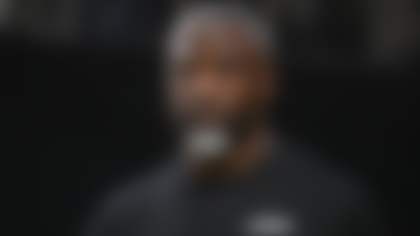All season long, Around The NFL's Marc Sessler will offer up his laundry list of heroes and villains from the week that was.
Heroes: The Bengals
Younger Bengals fans might not recall the living nightmare this franchise endured to emerge as one of the AFC's best teams.
While still looking for that first playoff win since 1991, Cincinnati has evolved into an organization filled with hope for the future because of a consistent and methodical approach that is finally paying off.
Some would say that owner Mike Brown was far too patient, keeping coach Marvin Lewis around no matter what the team produced. Others would argue that Lewis has been the patient one, toiling for a franchise that was slow to adopt a modern-day scouting department and unwilling to dish out big bucks for premier free agents.
These aren't the Patriots, not by a long shot, but the Bengals have matured into a functional organization with a clear approach to the draft, free agency, scouting and game-day scheming. As the league's longest-tenured coach next to Bill Belichick, Lewis has sought out and groomed "his guys" since 2003. It hasn't been perfect -- they still haven't won that playoff game -- but the Bengals have suffered just three losing seasons in 13 years.
It didn't happen immediately. During his first six years in Cincy, Lewis produced one 11-win season surrounded by a trio of 8-8 campaigns and two forgettable losing seasons. Since 2011, though, Lewis has piled up nine or more wins in five straight outings, adding strength upon strength to build one of the NFL's most talented rosters. The organization's no-panic approach applies to players, too, with Andy Dalton serving as the most obvious example.
I've written 40 billion posts calling for Dalton's head, but I was wrong. The Bengals were right.
Playing their best football since the '88 Super Bowl year, the Bengals are a case study in turning junk into treasure. Was it seamless? Did it happen overnight? No. Have the people in charge learned from their errors to unearth a working formula? Yes.
As Dan Hanzus wrote in last summer's Pain Rankings, Marvin Lewis raised the Titanic.
The results are on the field. Especially on Sunday, as Lewis and his Bengals dropped an A-bomb on their floating in-state rivals.
Villains: The Browns
The Bengals and Browns are forever linked through Paul Brown, Cleveland's legendary coach who founded the Bengals after he was shockingly fired by then-Browns owner Art Modell.
Considering that he also moved the "old Browns" to Baltimore in 1996, Modell is partly responsible for creating two AFC North clubs that now regularly beat Cleveland to a pulp.
But let's focus on today's team, because the Browns can't blame their current problems on the whipping-boy Modell.
Since Lewis was hired by the Bengals, Cleveland has shuffled through six full-time head coaches -- soon to be seven, if you believe the whispers.
When the Browns and Bengals both stunk for years, Cleveland fans knew they could count on bloodying Cincy at least once a season. For so long, the Bengals were just as inept as anything Chris Palmer, Butch Davis, Romeo Crennel, Eric Mangini, Pat Shurmur, Rob Chudzinski or -- almost finished -- Mike Pettine have churned out.
But not anymore. While the Bengals clung to their team-building philosophy, the Browns blew up the machine over and over in a stunning show of outward desperation. Nothing lasting, nothing real. While the Bengals have sought specific players to fit their scheme for more than a decade, hundreds of athletes have been wasted by Cleveland.
I can't help but think of Jabaal Sheard, the talented pass-rusher who faithfully produced under three different defensive coordinators in four seasons before finally leaving Cleveland last March to join the Patriots. Quietly one of this year's finest free-agent additions, Sheard is experiencing stability for the first time as a pro.
How about Joe Thomas, the uber-talented, good-natured left tackle who has toiled under five regimes and seen the team win seven-plus games just twice since 2007?
We all know about the starting quarterbacks -- 24 of them since '99 -- but it goes much deeper, with linemen, running backs, wideouts and defenders being drafted for one scheme, by one general manager, only to be rendered ill fits for the next doomed collection of suits. The current Browns decision-makers are without excuse, though, barely playing their own high draft picks.
It's no mystery why this once-proud franchise has become a laughing stock, fiercely mocked on Twitter, ripped by the media, taken down by funnymen, disregarded by the competition and viewed as a parable in how not to grow a professional sports team.
Here we sit, hours after the team has switched quarterbacks again. It was a decision that was made either by the coach, the general manager, the team president, the owner or a tangled collection of them all.
I can't help but think back to the league meetings in Phoenix last March. Around the NFL's Conor Orr and I were grabbing dinner at the hotel bar after a long day when Cardinals coach Bruce Arians strolled in with Steve Keim, the team's talented general manager. We noticed right away how they happily sat together, talking, laughing and living it up. Two peas in a pod.
It begins right there. With two people who want to work together, putting aside ego and fighting for something lasting. In the NFL, that fire-tested partnership is what attracts scouts, talent evaluators, assistant coaches, players, fans and Super Bowls.
One vision. One shared road. One unified plan to erase all the horror.
The Browns have never felt farther away.












